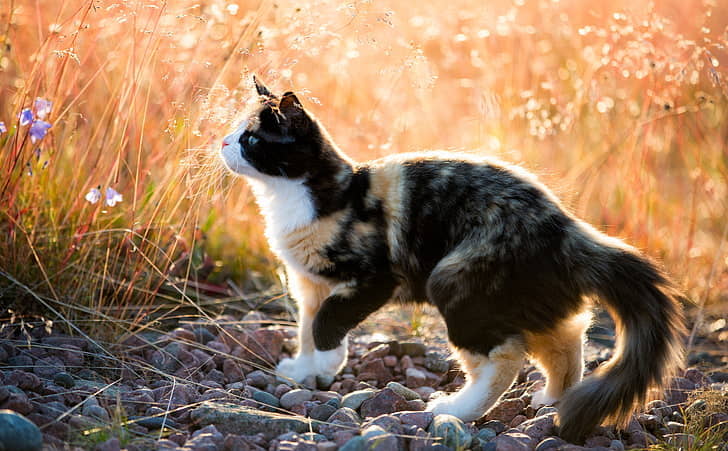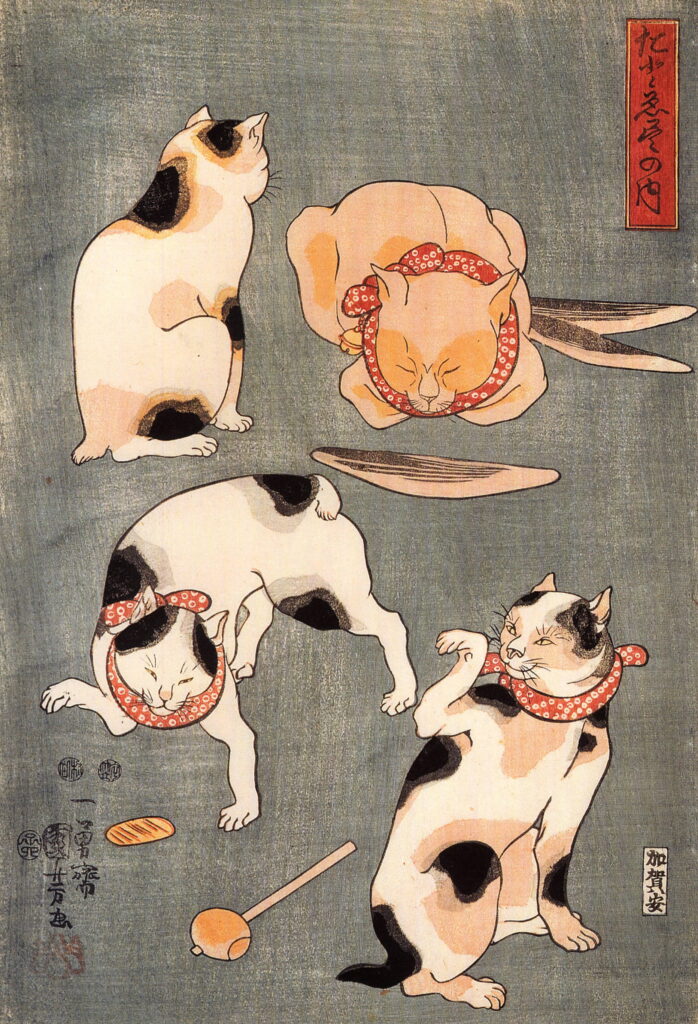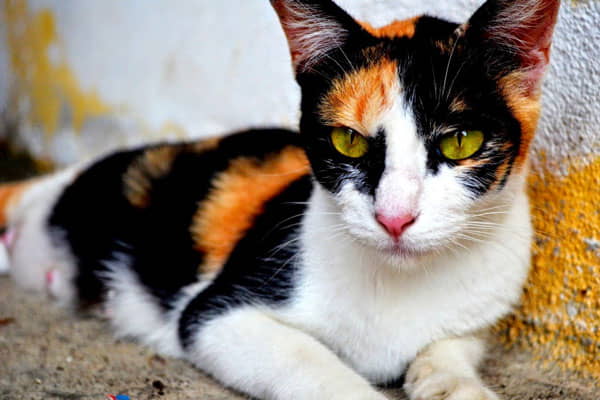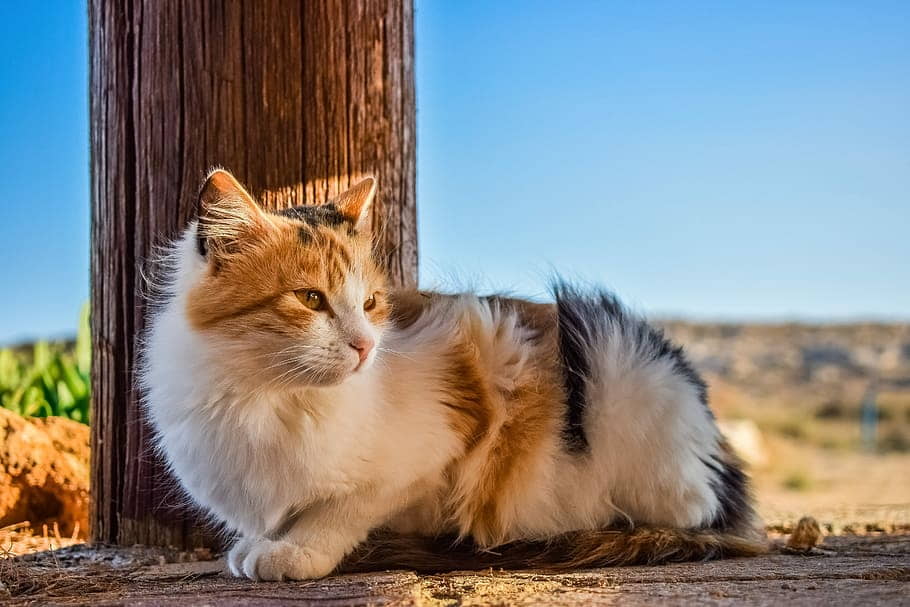Calico cats are wonderful! Keep in mind, calico cats are not a breed. Instead, calico refers to their tri-color coats which include black, orange and white. “Dilute” calicos may have gray, beige and white instead. Despite rumors to the contrary, calico cats are not all female, either—out of every 3000 calico kittens, one might be male! Several breeds of cats and mixtures of domestic cats can be calicos, including the American shorthair, Siberian and Japanese bobtail. Calico personalities can be as varied as their coats.

Rumored to be a bit feistier than other cats, recent studies confirm that pet parents have this perception, but NOT that calicos have this behavior. It may just be that calico lovers enjoy this perception and it’s been perpetuated.
That said, with so many cat parents saying they love their calico’s quirky nature, consider a calico if you’d like a kitty that will tell you what’s on her mind. As every calico is unique and from different heritage, their stats may range from 1-5 based on the individual.
Personality
Often called playful, affectionate and strong-willed, calicos have a reputation for being quirky. A 2015 study out of the University of California, Davis found that calico cat’s families reported that calicos may be more likely to hiss or otherwise say “back off” more often when compared to reports by cat parents of cats with other colors. But the study raises an eyebrow.
The researchers did not directly observe the cats and their behavior. This poses much leeway on the definition of “aggressive behaviors.” Without a standard measurement of “aggression,” it is easy to get a wide range of what constitutes and does not constitute aggression.
Researchers did acknowledge that other factors may be influencing a cat’s personality as well, like their breed, if they are neutered or not and what their home environment is like. There was also the possibility that parents mistake behavior as aggressive when, in actuality, it was an anxious response to stimuli.

So, what’s the bottom line? All calicos are unique. Because calico refers to coat characteristics and not a breed, it’s possible for calicos to have a wide range of dispositions. There are always other factors that come into play, such as their socialization and kittenhood environment.
The calicos we’ve met have been lovingly and adorably spunky, and excellent additions to their families!
History
The distinguishing orange-black-white of the calico is a genetic mutation that can be traced back to Egypt. The mutation was found in port cities along the Mediterranean Sea, including cities in Italy, Spain and France. These trade routes in northern Africa and Europe helped spread more than just the goods being transported—they brought the calico to new places, even to the U.S. eventually.
Strangely enough, the calico is a social influencer with a history. They sailed with Japanese fisherman to supposedly provide protection during storms and to scare away the apparitions of envious ancestors.
Calico cats have been painted in artwork around the world from the work Utagawa Kuniyoshi and Jean-Baptiste-Simeon Chardin. The infamous “beckoning cat” is an omen of good fortune and is often found outside businesses and homes around the world —the cat? A calico.

As a good luck omen, the calico may, in fact, work. A train station in the town of Kinokawa was saved in 2007 because of a calico. The townspeople appointed Tama, the local neighborhood stray, to the position of Station Master. She greeted passengers and drew in such a crowd that enough revenue was generated to save the train station from closing down. Maybe the calico does draw in good luck after all!
Station Master isn’t the only position calicos have held either. The calico has been dubbed the official cat of Maryland—to match its state bird, the oriole. The most famous, modern day calico is most likely Martha Stewart’s grumpy-faced Princess Peony. The adorable calico totes a mainly white body with black and orange on the tail and face. Her striking yellow-green eyes add an air of mystery to this sour-looking kitty.
Physical Attributes
COAT
Calico cat coats consist of three or more colors in their fur. They are typically black, white, orange or cream. The majority of the calico is white, and the other colors add a beautiful accent color found in patches along the body. Sometimes people mistakenly think a calico is a Tortoiseshell cat. But torties almost always have a brown hue as their base color with streaks of black and orange—with little to no white to be found on them.

Because calicos can belong to many different cat breeds, their fur length and other characteristics like face and nose shape vary from cat to cat.
The vast majority of calicos are female. The reason is that the coat colors in the calico come from a combination of two X chromosomes. The tri-color fur needs to have a pair of X chromosomes to appear. Since female cats have two X chromosomes, calicos will usually be female—but some males with an extra X–XXY–may have calico coloration. These cats will be male but also sterile and cannot create offspring.
Aside from Klinfelter’s Syndrome in males, calicos are generally healthy cats and live to 15 or longer, making them an awesome addition to any home.

Disclaimer
Note: While the characteristics mentioned here may frequently represent this breed, cats are individuals whose personalities and appearances will vary. Please consult the adoption organization for details on a specific pet.
Wondering about Chartreux ? Check it out on our next post!
